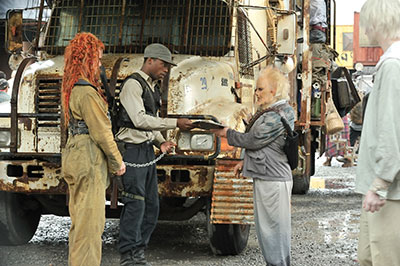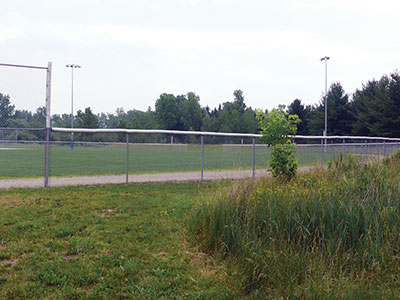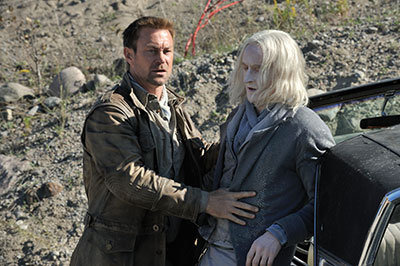
Features
Columns
Education
Using Rehabilitated Quarries
Agriculture not the only solution for rehabilitating inactive gravel pits.
December 2, 2013 By Treena Hein
On the day of this writer’s visit to an Uxbridge Township gravel pit in mid-September, it was buzzing with activity.
On the day of this writer’s visit to an Uxbridge Township gravel pit in mid-September, it was buzzing with activity. But it wasn’t the normal activity of crushing, screening, digging and loading trucks. It was the bustle of filming a popular new science-fiction television show.

|
|
An overturned car (from a stunt driving segment filmed the day before) and an old pile of gravel sporting deep rainstorm gouges formed the backdrop for the day’s filming. Alien plant life had been staked in the ground here and there to help establish a background with a futuristic feel. There were dozens of people all doing their part – actors, directors, producers, division managers and crew, with at least one stuntperson ready to do a downhill roll. When “action!” was called, shots were fired. “Green screens” also were held in place, on which a different background would be later digitally
inserted.
A small plane flew overhead, taking in the many production trailers and the entire area of filming activity from the air. A septic tank pulled up to empty nearby portapotties. Some employees of K.J. Beamish Construction (the company that owns the pit, headquartered in nearby King City, Ont.) were dampening the filming area. This was done to make the surface look the same as it had the day before after a rain, with the same-sized puddles, preventing any inconsistencies in the finished episode.

|
|
| The partial gravel base at the pit provides the perfect substance for up close road shots for the show.
|
The show being filmed in this Uxbridge Township gravel pit (as well as in nearby Toronto) is called Defiance, and it centres on a town of the same name. Defiance is set in 2046 on a “terra-formed” post-apocalyptic Earth where humans live alongside seven alien races. The series, now in its second season, features bar brawls, interspecies politics and an interesting pair of drifters who decide to settle in and shoulder new responsibilities.
Defiance breaks new ground in that it was released in 2012 both as a video game and as a TV show, a new genre known at transmedia. Five years in the making, it has an estimated production budget, including gaming development, of over $100 million. Defiance is being called the most ambitious transmedia venture yet, offering characters and storylines that crisscross between the Syfy network show and Trion Worlds game.
Unique location
The K.J. Beamish pit ended up being the set for some Defiance filming through a selection process spearheaded by Defiance location manager Brad Gratkowski and his assistant Paul Franklin. “We were looking for an area with a diversity of terrain, and one that has a look of not being used in a long time to match with the universe of the show,” Gratkowski explains. “We first contacted companies and took photos, developing a long list which we narrowed down to a few pits.” Gratkowski calls the Beamish pit “ideal,” with 70 acres of gravelly terrain along with scrubby brush and forest. “It’s rare to find a pit this close to Toronto with different types of backgrounds that looks fairly unused,” he says. “With the show being post-apocalyptic, an unused look is critical.” While the indoor building sets and town facade set are located in Toronto, the Uxbridge gravel pit is used to film road ambush and chase scenes, alien rituals, action shots and more. When they need a large outdoor set built, they build it in the pit. For example, the Defiance production crew built the “entrance” to a mine, which is of particular interest to the powerful and dangerous Earth Republic government featured in the show.
 |
|
| Sports fields, like this one found at a Lafarge pit near Paris, Ont., have become a popular use for progressive rehabilitation of gravel pits in Canada.
|
It’s a mad schedule, with 12-hour shooting days and seven days to finish each episode, but safety always comes first. “We are very strict about hazards such as steep hills, but we are all professionals, and we have a safety meeting first thing every day,” says Gratkowski. “We have a medic on set, and we ensure the use of hard hats, safety vests and steel-toed boots in accordance with Ministry of Natural Resources (MNR) regulations for a gravel pit site.”
In addition to the occasional small plane overhead, there are other distractions and challenges of working in a gravel pit in a semi-urban area. The honking of a flock of Canada geese might delay filming at any time, and the crew also has to work around the two days a week that a nearby gun club is open. “That background shooting sound could be useful in some scenes, but not others,” Gratkowski notes. “We’ve also had people on four-wheelers come in a couple of times and we’ve had to speak to them.”
This, of course, is far from the first time a gravel pit has been used for filming in Canada or elsewhere. James Dick Construction has allowed the filming of music videos on its property and Halton Crushed Stone has rented space to the film industry. In addition to renting out the gravel pit, Gratkowski says K.J. Beamish is also hired regularly by the Defiance production company to provide various types of support. In addition to using a water truck to dampen the filming area when needed, Beamish workers employ loaders and dozers to roll cars back over, build ramps, widen roads, build sets, remove stuck vehicles and more.
“The film industry benefits the economy a great deal,” says Gratkowski. “Every year, it brings $1.4 billion to the province. When we are working at this site, we may buy some supplies in Uxbridge and hire ‘extras’ and some security personnel.” Gratkowski has worked in the industry for many years and is hopeful that productions will continue to be based in Ontario. “Location-wise, this province is a gem,” he says. “It has every landscape you can imagine except snow-capped mountain peaks. There are good tax credits here, world-class industry crews and great film industry infrastructure.” It’s a project-based industry, however, and looking for the next contract is a constant reality. “You have to be a complete professional as your reputation is everything,” Gratkowski says.
Uxbridge Township
Uxbridge Township sits on the Oak Ridges Moraine and possesses high-quality aggregates. The municipality currently has 33 aggregate pits operated by 16 companies. When Gerri Lynn O’Connor became mayor in 1980 (she has won every election since, retired in 2006 and returned in 2010), she and her staff and counsellors set up an aggregates working group. In those first meetings, everyone established their needs, and O’Connor says ever since then, relations have been very good. She believes that sitting down and figuring out where everyone is coming from will solve any issues. “If you’re a municipality with aggregates, you should find ways of working with aggregate companies,” O’Connor says.

|
|
| The rugged terrain throughout the pit area has been used as the backdrop for several scenes of the show in the first and second season.
|
Uxbridge aggregate companies have long been expected to take part in a countryside land-use plan, developed by the township, citizens, local community groups, conservation authorities and the MNR. This ensures, says O’Connor, that the end use of the township’s facilities enhances existing trail systems, stewardship and other developments. She notes that the aggregate industry also supports the efforts of community groups with donations of materials, financial contributions, land exchanges and easements for public use.
O’Connor (who says she’s “very happy” about Defiance) notes that “aggregate is an important resource for the township. Gravel resources are a big part of the moraine makeup and the Township of Uxbridge realizes we must co-exist in order for things to work for both sides.”
Rehabilitated gravel pits
Minimizing the environmental impact of gravel extraction and rehabilitating used-up quarries and pits are more important than ever to Canada’s aggregate industry. Some of the best-known natural landmarks in Ontario used to be quarries or pits, states the Ontario Stone, Sand and Gravel Association (OSSGA), including more than 70 rehabilitated sites within the city of Toronto alone. According to OSSGA, “Quarries and pits are a
temporary land use. The rehabilitation is carefully planned: the land is shaped to support the end use and prevent erosion, and the original topsoil is replaced.” The OSSGA “Bronze Plaque Award” is given to those sites that demonstrate rehabilitation compatible with the surrounding landscape, outstanding site design and rehabilitation, and outstanding ongoing site management. Among the 19 recipients is the Swimming Quarry in St. Marys.
Reducing the need for new gravel pits and expansion of pits is also important. In July 2012, The Cornerstone Standards Council (CSC) was formed to encourage the use of responsibly sourced (much of it recycled) roadbuilding and construction materials through the creation of world-class voluntary social and environmental certification standards.
In the coming months, the CSC Standards Panel will release the First Draft Standards and seek feedback through several methods.
Uses of rehabilitated gravel pits in Ontario:
(Information provided by the Ontario Stone, Sand and Gravel Association)
- general recreation, such as all-terrain vehicle use, hiking, bird-watching, mountain biking, fishing (e.g., Snyder Flats outside of Waterloo)
- forest and wetland habitat for wildlife
- outdoor dog training area near Puslinch, Ont.
- vineyards and stone fruit orchards in the Brampton and Niagara Area
- paintball in the Ottawa area
- numerous golf courses
- equestrian stables and training
- arenas, Aberfoyle and Perth areas
- triathlete training in the rehabilitated portion of the James Dick pit
- in Caledon
- fish hatchery
For more on OSSGA rehabilitation study, see http://ossga.com/multimedia/51/ossga_rehabilitation_study_part_1_-_1971-2009.pdf .
Print this page